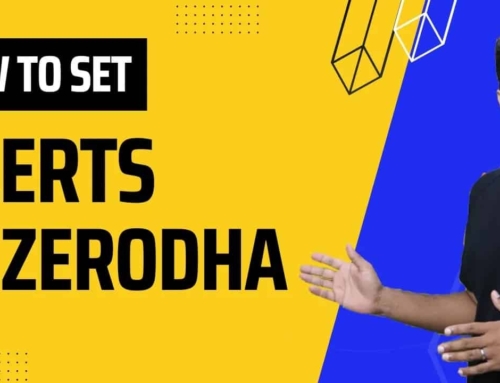What is Shorting or Short Selling?
Shorting is a very important concept for traders but a lot of beginners either get confused or do not completely understand how it works. Today we will cover everything that is there to know about shorting.

Traditional Mindset
Most of us grew up with the understanding that the only way to make money in the stock market is by buying good stocks at a low price and sell them at a higher price. That method works well in investing where investors benefit from rising prices.
However, what happens when the markets are falling?
When the markets are falling, the investors starts getting nervous looking at their portfolio. However, traders start to get excited like a kid in the candy store. But why? Because in order to make money from trading you need a clear price movement – either upward or downward. It doesn’t matter which way.
When the market or specific stocks are trending downward, a trader makes money by shorting.
Sell first, buy later
Shorting is selling first and buying later, plain and simple. You can short the market (i.e. index such as NIFTY, Bank Nifty) or specific stocks (such as DLF, Reliance, TCS etc.).
Now, a lot of beginners (rightly ask): how can we sell shares of a company first when we don’t have any previously bought shares. Short answer is that you don’t need the shares to sell them – your broker automatically lends them to you. More on this in the Part 4 of this series, here.
The mechanics of how it is possible is not important; what is important is the fact that it is possible to short the market. Honestly, when I first learned about shorting, I was like “No, way ! they let you do that” .
Trust me, as a trader you need every advantage possible and being able to short is a big advantage in the Indian market.
Short sellers benefit from falling prices

For example, someone who has shorted 1000 shares of Infosys and is looking to close the position, is supposed to buy 1000 shares. Whereas beginners often place another sell order- which basically means you doubled your shorting position instead of exiting from the trade. It can be a very costly mistake.
Let us learn shorting from a quick story
This is a quick story of three friends (and a phone).
Anita wants buy a new iPhone but doesn’t have time to go to the store and pick one up.
Ritesh (imagine yourself) is her friend and happens to have a good trading sense. He tells Anita to pay ₹20,000 (current market price of brand new iPhone) and he will get a brand new piece with all the warranty and stuff.
Anita is delighted and pays him ₹20k.
Now, Ritesh doesn’t have a brand new phone but he knows his friend Chetan does. So, he goes to Chetan and makes this deal : “you rent me a brand new phone for a week and I will pay you ₹1000 for that. At the end of the week, I will give you back a brand new piece of iPhone” . Chetan is very happy to cut this deal and hands over the phone to Ritesh.
Ritesh takes that phone and gives it to Anita, as promised. She is very happy and thankful to him. At this point in the story, Anita and Chetan seem to be doing fine but how about Ritesh? What’s in it for him?
Well, Ritesh knew something that others did not. He came to know from his sources that Apple would launching a new iPhone model next week and if that happens, the price of the old model (which he got from Chetan) would fall. As luck would have it, Apple did announce the launch and the price of old iPhone model went down to ₹15,000. So, all he had to do was to go to an Apple store, buy the older model for ₹15,000 and give it to Chetan.
How much did Ritesh make in this whole deal?
{₹20,000 – ₹15,000 – ₹1,000} = ₹4,000
Not bad, right? So, what Ritesh did was basically short selling.
- He sold first (to Anita) and bought later (for Chetan)
- He sold something he didn’t have at the time.
- He did all this because he anticipated the price to fall.
Now, substitute
- Anita –> Buyer,
- Ritesh –> Short Seller
- Chetan –>broker (e.g. Zerodha) and
- iPhone –>Shares (e.g. of Reliance)
A short seller basically sells first by borrowing shares from his broker with the anticipation of fall in prices. If you understood that example, you basically understood shorting.
Let us see how shorting works in stocks
Now, let us say you are bearish on Reliance Industries because the JIO business is not as profitable as people had earlier though. After the recent quarterly earnings announcement, the stock is facing some heavy selling pressure.
The stock is currently trading at ₹1000 and you are expecting it to fall on an intraday basis. So, you shorted 500 shares of Reliance at ₹1000. There are three ways in which the stock could move:
| Scenario | # of Shares | Selling Price | Buy Price | Net Profit/Loss | #of Shares* (Sell Price-Buy Price) | |
| #1 | Stock price falls to ₹950 | 500 | ₹1000 | ₹950 | ₹25,000 profit | = 500*(1000-950) |
| #2 | Stock price goes to ₹1100 | 500 | ₹1000 | ₹1100 | (₹50,000) loss | = 500*(1000-1100) |
| #3 | Stock price stays same | 500 | ₹1000 | ₹1000 | ₹0 | = 500*(1000-1000) |
As you can see, when you short a stock, you profit when the stock goes down and incur loss when the stock goes up.
Shorting was designed for investors 
In spite of being a darling of traders, shorting was not originally designed for traders.
Shorting was (and is still) intended for investors who want to protect their portfolio from sudden market falls. By shorting the market, an investor can get a good night sleep that even though his portfolio value might go down in the event of a big market fall, the value of the short position will compensate for the loss, to a large extend.
Let us get the terminology right
It is important to understand the terminology correctly:
- Long position: buying first with the anticipation of rise in price
- Short position : selling first with the anticipation of fall in price
- Bull : traders who expect the prices to go up
- Bear : traders who expect the prices to go down
- Covering short: buying the shares from the market to give it back to the broker (like Ritesh bought iPhone from the market)
Objections to Shorting
These are the three most frequently raised objections pertaining to shorting:
- It is unnatural:
- Shorting seems unnatural and a lot of beginners feel very uncomfortable taking a short position. I get that.
- My only counter argument is whether swimming is natural? God did not give us fins, we cannot breathe under water and it is surely not easy to lean swimming. But in spite of being “unnatural”, do not we learn swimming and some even become masters at it?
- So the question should not be whether it is natural or not; the real question is whether it is profitable or not.
- Take it from me, it is more profitable that you think.
- It is anti national
- This objection is actually stupid but I will address it anyway. People think that by shorting a company they are harming it somehow and in a big picture, it harms our economy somehow.
- To that, I say a) you completely overestimated your influence on the market and b) in every trade you have to do both buying and selling so how is it that doing in reverse does any harm to the company.
- There are are special cases, which will discuss in Part 4 of the series where activist investors can make a dent in a company but by no stretch of imagination, it can harm the economy.
- So, don’t feel guilty: just because you shorted TCS doesn’t make you a traitor to the country.
- It is risky
- This is the only legitimate objection and I will address that in Part 2. At this point, I just want to emphasize that there is a risk asymmetry between taking long and short trades.
Importance of Shorting
Shorting plays these three important roles:
- Provides Liquidity
- Without the short sellers, the liquidity in the market will go down drastically, especially given that the big players like Foreign Institutional Investors (FII) are very active in Indian market and frequently take short position
- Hedging
- As we discussed earlier, shorting is portfolio’s umbrella for the rainy days. You can’t build a significant portfolio without hedging it with shorts
- Trader’s Left Hand
- If going long is a trader’s right hand, going short is his left hand. If you are a trader and are only fighting with hand, you are missing out of almost half of the opportunities to hit back. (watch the Manny Pacquio’s video to see what I am talking about)
Howdy!
If you’re here for the first time, let’s get introduced.
VRD Nation is India’s premier stock market training institute and we (Team VRD Nation) are passionate about teaching each and every aspect of investing and trading.
If you’re here for the first time, don’t forget to check out “Free Training” section where we have tons of free videos and articles to kick start your stock market journey.
Also, we got two awesome YouTube channels where you can continue the learning process.
Must-Read Articles
What is Shorting or Short Selling?
Shorting is a very important concept for traders but a lot of beginners either get confused or do not completely understand how it works. Today, we will cover everything that is there to know about shorting.

Traditional Mindset
Most of us grew up with the understanding that the only way to make money in the stock market is by buying good stocks at a low price and sell them at a higher price. That method works well in investing where investors benefit from rising prices.
However, what happens when the markets are falling?
When the markets are falling, the investors starts getting nervous looking at their portfolio. However, traders start to get excited like a kid in the candy store. But why? Because in order to make money from trading you need a clear price movement – either upward or downward. It doesn’t matter which way.
When the market or specific stocks are trending downward, a trader makes money by shorting.
Sell first, buy later
Shorting is selling first and buying later, plain and simple. You can short the market (i.e. index such as NIFTY, Bank Nifty) or specific stocks (such as DLF, Reliance, TCS etc.).
Now, a lot of beginners (rightly ask): how can we sell shares of a company first when we don’t have any previously bought shares. Short answer is that you don’t need the shares to sell them – your broker automatically lends them to you. More on this in the Part 4 of this series, here.
The mechanics of how it is possible is not important; what’s important is the fact that it is possible to short the market. Honestly, when I first learned about shorting, I was like “No, way ! they let you do that” .
Trust me, as a trader you need every advantage possible and being able to short is a big advantage in the Indian market.
Short sellers benefit from falling prices

For example, someone who has shorted 1000 shares of Infosys and is looking to close the position, is supposed to buy 1000 shares. Whereas beginners often place another sell order- which basically means you doubled your shorting position instead of exiting from the trade. It can be a very costly mistake.
Let us learn shorting from a quick story
This is a quick story of three friends (and a phone).
Anita wants buy a new iPhone but doesn’t have time to go to the store and pick one up.
Ritesh (imagine yourself) is her friend and happens to have a good trading sense. He tells Anita to pay ₹20,000 (current market price of brand new iPhone) and he’ll get a brand new piece with all the warranty and stuff.
Anita is delighted and pays him ₹20k.
Now, Ritesh doesn’t have a brand new phone but he knows his friend Chetan does. So, he goes to Chetan and makes this deal : “you rent me a brand new phone for a week and I will pay you ₹1000 for that. At the end of the week, I will give you back a brand new piece of iPhone” . Chetan is very happy to cut this deal and hands over the phone to Ritesh.
Ritesh takes that phone and gives it to Anita, as promised. She is very happy and thankful to him. At this point in the story, Anita and Chetan seem to be doing fine but how about Ritesh? What’s in it for him?
Well, Ritesh knew something that others didn’t. He came to know from his sources that Apple would launching a new iPhone model next week and if that happens, the price of the old model (which he got from Chetan) would fall. As luck would have it, Apple did announce the launch and the price of old iPhone model went down to ₹15,000. So, all he had to do was to go to an Apple store, buy the older model for ₹15,000 and give it to Chetan.
How much did Ritesh make in this whole deal?
{₹20,000 – ₹15,000 – ₹1,000} = ₹4,000
Not bad, right? So, what Ritesh did was basically short selling.
- He sold first (to Anita) and bought later (for Chetan)
- He sold something he didn’t have at the time.
- He did all this because he anticipated the price to fall.
Now, substitute
- Anita –> Buyer,
- Ritesh –> Short Seller
- Chetan –>broker (e.g. Zerodha) and
- iPhone –>Shares (e.g. of Reliance)
A short seller basically sells first by borrowing shares from his broker with the anticipation of fall in prices. If you understood that example, you basically understood shorting.
Let’s see how shorting works in stocks
Now, let’s say you are bearish on Reliance Industries because the JIO business is not as profitable as people had earlier though. After the recent quarterly earnings announcement, the stock is facing some heavy selling pressure.
The stock is currently trading at ₹1000 and you are expecting it to fall on an intraday basis. So, you shorted 500 shares of Reliance at ₹1000. There are three ways in which the stock could move:
| Scenario | # of Shares | Selling Price | Buy Price | Net Profit/Loss | #of Shares* (Sell Price-Buy Price) | |
| #1 | Stock price falls to ₹950 | 500 | ₹1000 | ₹950 | ₹25,000 profit | = 500*(1000-950) |
| #2 | Stock price goes to ₹1100 | 500 | ₹1000 | ₹1100 | (₹50,000) loss | = 500*(1000-1100) |
| #3 | Stock price stays same | 500 | ₹1000 | ₹1000 | ₹0 | = 500*(1000-1000) |
As you can see, when you short a stock, you profit when the stock goes down and incur loss when the stock goes up.
Shorting was designed for investors 
In spite of being a darling of traders, shorting was not originally designed for traders.
Shorting was (and is still) intended for investors who want to protect their portfolio from sudden market falls. By shorting the market, an investor can get a good night sleep that even though his portfolio value might go down in the event of a big market fall, the value of the short position will compensate for the loss, to a large extend.
Let’s get the terminology right
It’s important to understand the terminology correctly:
- Long position: buying first with the anticipation of rise in price
- Short position : selling first with the anticipation of fall in price
- Bull : traders who expect the prices to go up
- Bear : traders who expect the prices to go down
- Covering short: buying the shares from the market to give it back to the broker (like Ritesh bought iPhone from the market)
Objections to Shorting
These are the three most frequently raised objections pertaining to shorting:
- It’s unnatural:
- Shorting seems unnatural and a lot of beginners feel very uncomfortable taking a short position. I get that.
- My only counter argument is whether swimming is natural? God didn’t give us fins, we can’t breathe under water and it’s surely not easy to lean swimming. But in spite of being “unnatural”, don’t we learn swimming and some even become masters at it?
- So the question should not be whether it is natural or not; the real question is whether it is profitable or not.
- Take it from me, it is more profitable that you think.
- It’s anti national
- This objection is actually stupid but I will address it anyway. People think that by shorting a company they are harming it somehow and in a big picture, it harms our economy somehow.
- To that, I say a) you completely overestimated your influence on the market and b) in every trade you have to do both buying and selling so how is it that doing in reverse does any harm to the company.
- There are are special cases, which will discuss in Part 4 of the series where activist investors can make a dent in a company but by no stretch of imagination, it can harm the economy.
- So, don’t feel guilty: just because you shorted TCS doesn’t make you a traitor to the country.
- It’s risky
- This is the only legitimate objection and I will address that in Part 2. At this point, I just want to emphasize that there is a risk asymmetry between taking long and short trades.
Importance of Shorting
Shorting plays these three important roles:
- Provides Liquidity
- Without the short sellers, the liquidity in the market will go down drastically, especially given that the big players like Foreign Institutional Investors (FII) are very active in Indian market and frequently take short position
- Hedging
- As we discussed earlier, shorting is portfolio’s umbrella for the rainy days. You can’t build a significant portfolio without hedging it with shorts
- Trader’s Left Hand
- If going long is a trader’s right hand, going short is his left hand. If you are a trader and are only fighting with hand, you are missing out of almost half of the opportunities to hit back. (watch the Manny Pacquio’s video to see what I am talking about)


















![What is Virtual Contract Note [Zerodha]](https://www.vrdnation.com/wp-content/uploads/2023/10/maxresdefault-virtual-note-500x383.jpg)



Explained in a simple way. Liked it. Understood it. I faced a few of these barriers but over the period I realized the benefits of the same.